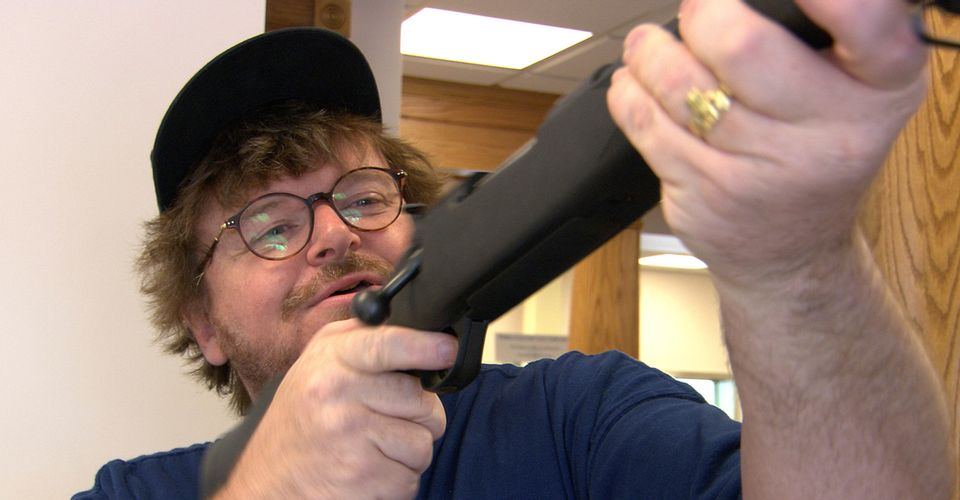15 Most Controversial Documentaries Ever Made

We watch documentaries to be informed. While nobody has ever balked at a documentary that’s as entertaining as it is informative, the appeal of the entire documentary concept is based on the fundamental joy that one derives from learning more about a particular part of our world. The documentary industry wouldn’t exist unless there were enough people in the world who are willing to not only learn about something new but learn more about something that they thought they already knew.
This makes it all the more strange to consider how easily a documentary can become truly controversial. The idea behind a documentary is that a filmmaker wants to devote a lens to some part of our world or shared history that they feel everyone needs to see. Oftentimes, though, these filmmakers soon find out that there are many people in the world who simply didn’t want to know more about that part of our world – or at least didn’t want to see it portrayed in the manner that it was. The most controversial documentaries of all-time not only inform us of a particular subject, they remind us that nothing will ever be as controversial as the world we go to other movies to escape from.
These are the 15 Most Controversial Documentaries Ever Made.
15 The Bridge

Did you know that San Francisco’s Golden Gate Bridge is one of the most popular suicide destinations in the world? When filmmaker Eric Steel learned this fact, he set out to make The Bridge; a documentary which aimed to not only discover why Golden Gate Bridge is such a popular suicide destination, but show people committing – or attempted to commit – the act itself.
Steel’s goal wasn’t to turn suicide into entertainment, but rather to expose just how little is being done to prevent people from killing themselves by jumping off the bridge. In the process, he also sheds a little light on the often confusing culture of suicide itself. Still, there are many who claimed that The Bridge only encouraged people to commit suicide by somehow normalizing the action. Members of the Golden Gate National Recreation Area agency have also stated that Steel failed to disclose his true intentions when he requested a filming permit.
14 Blackfish

Over the course of almost twenty years, Tilikum the Orca was responsible for the deaths of three people across various water parks the creature performed at. Filmmaker Gabriela Cowperthwaite looked beyond the tragedy of these deaths and focused on the tragedy of the Orca’s captivity. In a 2013 documentary called Blackfish, she shifted the blame towards SeaWorld. Cowperthwaite’s allegations were based on her belief that captivity was turning these creatures into violent animals with drastically shortened lifespans.
As you might imagine, Blackfish was not a favorite film among SeaWorld executives, who were now forced to answer a barrage of questions regarding whether or not they were responsible for these murders as well as the tortured lives of their most famous performers. SeaWorld representatives claimed that Cowperthwaite had twisted certain pieces of information to her benefit in order to sensationalize a tragedy. Nevertheless, SeaWorld’s business was undoubtedly hindered. They were eventually forced to end their orca breeding program as well as all orca performances.
13 The Thin Blue Line

True crime documentaries, podcasts, shows, and films are more popular than ever, but that wasn’t necessarily the case when director Errol Morris’ The Thin Blue Line premiered in 1988. Granted, Morris never seemed particularly concerned with whether or not anyone was entertained by his story. Instead, he wanted to inform the world of why the arrest of Randall Adams by the Dallas Police Department should be considered one of the most blatant cases of injustice in modern American history.
The Thin Blue Line exposed the mix of incompetence and corruption that led to Adams spending over10 years in jail for a crime he certainly did not commit. While it’s understandable why the members of the Dallas Police Department who were involved in the case were upset to see how the facts were presented, others argued that Morris’ film did little more than inspire people to mistrust – or openly rebel against – the police. Nevertheless, the movie was responsible for Adams receiving a retrial and subsequent acquittal.
12 An Inconvenient Truth

An Inconvenient Truth wasn’t the first piece of media to trigger a debate regarding the validity of global warming. Far from it. However, this 2006 film stands as one of the most convincing arguments for the imminent danger that climate change presents. An Inconvenient Truth saw director Davis Guggenheim combine a series of town hall speeches given by former vice president Al Gore with other pieces of relevant footage to argue that global warming isn’t a matter of debate — it’s an inconvenient truth.
Of course, yet another debate still emerged following the film’s premiere. An Inconvenient Truth’s compelling argument inspired outrage from those who agreed with the film’s views on global warming and those who disagreed. Those who agreed with the movie suddenly called the Bush administration’s attitude towards the issue into question, while those who disagreed were quick to write the movie off as little more than fear mongering fuelled by inaccurate information. The global warming debate has only gotten hotter (wink) since the film’s release.
11 Nanook of the North

From a filmmaking perspective, Nanook of the North is one of the most important movies ever released. This 1922 film about the lifestyle of an Inuk man named Nanook and the people that hold to the Inuit ways is historically remembered as the first full-length documentary. It showcased a harsh form of life that modern audiences couldn’t believe existed alongside their relatively comfortable existences.
Their disbelief was only fueled by allegations that Nanook was little more than a series of dramatized events. Following the film’s release, critics and historians accused director Robert J. Flaherty of staging many of the film’s most memorable sequences and for simply lying about the relationship of some of the movie’s characters. While some argued that this negated the film’s impact, others have stated their belief that the staged aspects do nothing to diminish the significance of the film. They believe that the Flaherty’s manipulations were performed in service of presenting the story he was trying to tell in a way that would survive the technical limitations of the time. It’s a debate which haunts the documentary genre to this day.
10 Fahrenheit 9/11

When it was announced that director Michael Moore’s next film was going to be a cinematic takedown of the Bush administration as well as the dangerous ideology of American patriotism, people everywhere began supporting or denouncing the movie with furious vigor. Disney CEO Michael Eisner reportedly even led the charge to get Miramax to drop the film.
The eventual release of Fahrenheit 9/11 only inspired more controversy. The crux of the debate surrounding the film involved Moore’s satirical stylings. Some argued that Moore tried too hard to make his movie entertaining and, in the process, would often distort pieces of information in a way that helped further his filmmaking agenda. Those who already fundamentally opposed the Bush administration, meanwhile, were shocked to see just how the post-9/11 environment in America allowed President Bush and other government officials to get away with certain acts seemingly done to preserve truth, justice, and the American way. As you no doubt know, many of the debates the movie inspired rage on to this day.
9 Zeitgeist: The Movie

There are actually three documentary films bearing the Zeitgeist name, but for the purposes of this discussion, we’re talking about the 2007 production known as Zeitgeist: The Movie. This two-hour film is divided into three distinct parts that each address a particular conspiracy theory. The first part deals with a claim that Christianity is a kind of patchwork religion cobbled together by pieces from other cultures. The second addresses the claim that the U.S. government let 9/11 occur in order to further their political agenda. The third deals with the allegation that the U.S. Federal Reserve is controlled by a small group of bankers. Collectively, these conspiracy theories are some of the most popular of their kind in the modern internet age.
Oh boy…where to start? Well, the subjects themselves are no doubt controversial, but what really made Peter Joseph’s Zeitgeist stand out was the way that Joseph presented these theories in a professional manner that was a far cry from the classic “tin hat” presentation methods they were previously often subject to. In fact, some who vehemently disagree with the movie’s messages still argue that it is a fascinating look at how easily conspiracy theories can be validated in the modern age.
8 Jesus Camp

At a time when the American horror movie industry was hitching their fortunes to the torture porn movement, directors Heidi Ewing and Rachel Grady came along and truly terrified moviegoers with one of the scariest stories ever committed to film. 2006’s Jesus Camp captured the daily activities of a group of children who attended the Kids on Fire School of Ministry, a religious summer camp. Ewing and Grady attempted to showcase the fervent nature of this religious group and how the adults that run this camp isolate impressionable children in order to spread their particular beliefs.
Those who did not hold to this group’s beliefs and/or methods left their viewing of Jesus Camp ironically praying that the events of the film were somehow a fabrication. The greater controversy surrounding the movie actually has little to do with whether or not the events portrayed in the film are a fabrication. There have been allegations that the directors manipulated the presentation of certain occurrences to their benefits, but none of them seem to hold much weight. Instead, there are some who walked away from the film with the distinct impression that the directors intended to use the movie as an attack on Christianity as a whole. Indeed, distributor Magnolia pictures even pulled the film from Michael Moore’s film festival out of fear that the association would label Jesus Camp as an “agenda-laden film.”
7 Zoo

There are aspects of existence which many people have a vague knowledge of, but prefer to remain in the dark about. It’s the same principle of protection that inspires children to hide their head under the blanket when monsters approach. Zoo sheds light on a certain aspect of existence that many people can safely say that they never really devoted much time to and never really intended to dwell on more than necessary. In this 2007 film, director Robinson Devor explores the circumstances surrounding the death of a man named Kenneth Pinyan, who died while trying to engage in a sexual act with a horse. The movie also looks at the culture of people who enjoy participating in similar acts.
Unlike some of the other movies on this list, which were made all the more controversial by the accusation that the people behind them attempted to glorify a certain subject through enhanced production techniques, much of Zoo’s controversy can be traced back to Devor’s decision to cover this particular subject at all. While Zoo is an incredibly low-key movie, the documentary’s harshest critics argue that Zoo is, by its very nature, on par with those aforementioned torture porn films in terms of merit.
6 Lake of Fire

By the time that Tony Kaye’s Lake of Fire was released in 2007, the debate surrounding the ethics of abortion was far from resolved – spoiler alert: it still isn’t – but had been covered by so many feature films and documentaries that many wondered if we really needed another take on the subject at all. Lake of Fire appropriately reignited the debate by refusing to take a side on the matter. Instead, it showcased the views of pro-life and pro-choice advocates in a fairly even light, giving screen time to extremists from both sides.
What really made the movie controversial, however, was Kaye’s decision to graphically portray the abortion process. Like all other aspects of the movie, this process is depicted in an unsentimental way. The nature of this footage angered both pro-life advocates who were shocked by the visual, and pro-choice advocates who argued that the footage was presented in order to an attempt to further the director’s hidden pro-life agenda.
5 Bowling for Columbine

Before he ignited a political firestorm with Fahrenheit 9/11, director Michael Moore tackled the subject of violence in America with his 2002 film Bowling for Columbine. The film’s title is derived from the infamous 1999 shooting known as the Columbine High School Massacre, as well as the revelation that the students who perpetrated that event attended a bowling class just hours before the murders occurred. Moore – like many Americans at the time – wanted to understand how it was that two students could start their morning by bowling and end it by killing 12 students and a teacher.
At a time when many people had managed to cope with the events at Columbine by simply suggesting that the kids at the center of it were pure evil, Moore argued that it was entirely possible that they were the by-product of a culture of violence that remained unchecked. This argument not only upset pro-gun advocates who were none too fond of Moore’s views on firearms – nor his controversial suggestions regarding how easy it is to acquire a gun in America – but also managed to disturb people on both sides of the issue who were shocked to see the film’s uncensored displays of violence.
4 Capturing the Friedmans

Filmmaker Andrew Jarecki originally set out to make a short film called Just a Clown that focused on a professional clown named David Friedman. Along the way, Jarecki learned that Friedman’s brother and father had both been convicted of child sexual abuse. With the help of David’s supply of home videos, he soon began exploring the events that led to their guilty pleas in order to determine what exactly happened.
When Arnold and Jesse Friedman pleaded guilty to child abuse charges, few people who afforded the matter a casual glance had reason to cast doubt over their conviction. The evidence seemed overwhelming. Capturing the Friedmans managed to convince some people that there was a very good chance the Friedmans had been coerced into confessing to a crime they did not commit. Part of the reason why the movie is so controversial is because it put people in the awkward position of potentially sympathizing with two people who had seemingly committed an unspeakably awful act. That frightening ambiguity left many people feeling like they preferred to never know the Friedmans at all.
3 Earthlings

With the possible exception of Lake of Fire, Earthlings is the most notable example of a controversial documentary that earns that reputation not so much because of what it argues, but rather because of what it shows. Earthlings is a 2005 documentary from director Shaun Monson that attempts to argue against humanity’s cruel treatment of animals. In order to make this argument, Monson displays footage from the daily practices of several large industries which rely on animals.
That frustratingly vague summary is an unfortunate necessity in this instance. Earthlings doesn’t just show footage of animal abuse, it shows footage that is so horrific that we can’t really relay the full details of their content. Along with representatives from the various industries portrayed in the film, Earthlings angered crowds of people who attributed director Shaun Monson’s film to his desire to further his vegan lifestyle through scare tactics. They argued that the movie’s most shocking moments – many of which occurred at dog breeding institutions known as puppy mills – were not nearly as common as the director would have you believe.
2 The Act of Killing

Murder is so commonplace in films that few people even bother to act shocked when a movie’s hero effortlessly kills waves upon waves of adversaries. In this 2012 documentary, director Joshua Oppenheimer attempts to reignite the horror of murder in even the most sedated of filmgoers by focusing on a group of people who committed murder as part of the Indonesian genocide of 1965-1966. Much of the film focuses on a local gangster named Anwar Congo, who reportedly murdered over 1,000 people.
Anwar Congo is not only the focus of the film, but the center of much of the controversy that surrounds The Act of Killing. Oppenheimer gets Anwar to recreate his various murders in the cinematic style of westerns, gangster films, and other forms of media which portray violence in an almost romantic way. The director’s intent is to get Anwar to recognize that what he did was evil, but as Anwar’s convictions hold, the film becomes almost cinematically violent in and of itself. The film’s harshest critics argue that the movie ultimately glorifies violence for the director’s own purposes. Everyone else considers it to be one of the greatest documentaries ever made.
1 Titicut Follies

Many of the films on this list are controversial because they present an issue which is open to some debate. Titicut Follies is controversial because it exposed an issue that horrified nearly everyone who saw it, regardless of their personal beliefs. In this 1964 documentary, director Frederick Wiseman explores the inner-workings of the Bridgewater State Hospital. While filming in the hospital, Wiseman witnessed and captured unspeakable acts of patient mistreatment that included forced feedings, misdiagnosis, and instances involving people being forced to strip naked. The worst part is that the people who ran the facility apparently saw all of this as rather routine.
As if the content of the film wasn’t controversial enough, the anger surrounding the release of Titicut Follies peaked when the state of Massachusetts attempted to block the film from ever being released. In the process, Titicut Follies became the first – and only – American filmed banned by the government for a reason other than obscenity or national security. Some claimed the movie was banned to protect the privacy of those portrayed in the film, which is almost darkly amusing when you consider how the people in the film were treated. Once the movie was finally released to the public in 1991, millions discovered one of the most shocking documentaries ever made.
—
What other shocking documentary films led to a wave of controversy? Let us know in the comments.

















